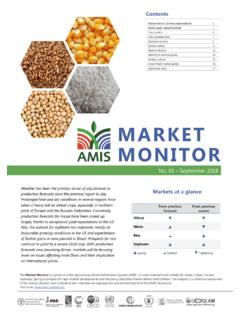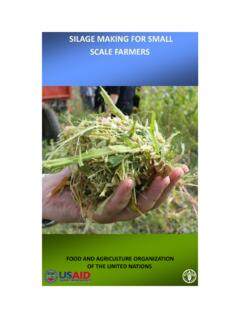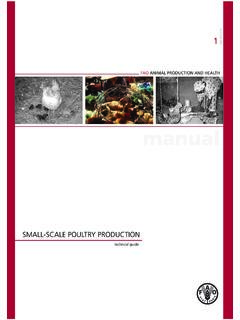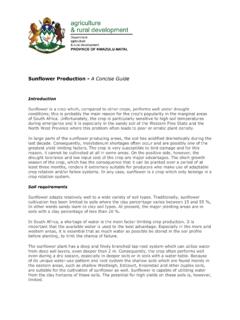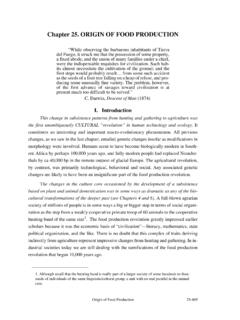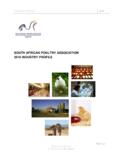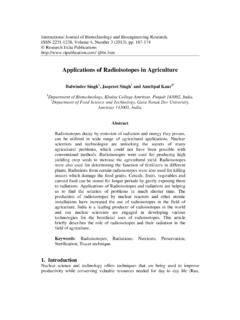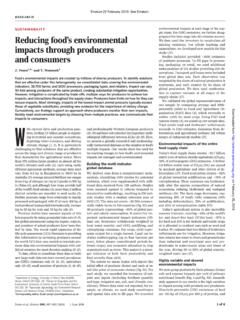Transcription of CORN IN THE PHILIPPINES: ITS PRODUCTION AND …
1 CORN IN THE PHILIPPINES: ITS PRODUCTION AND RESEARCH ACTIVITIES WITH EMPHASIS ON DOWNY MILDEW Ofelio R. ExcoNDE* 21 Corn is one of the most important staple crops in the Philippines. It ranks second to rice in the utilization of agricultural resources. It is used not only for human consumption but also for animal feeds and industrial uses, hence it is a vital crop in the development of the livestock and manufacturing industries. This paper presents the status of maize PRODUCTION , the economic importance and some research activities on downy mildew. PRODUCTION As shown in Table 1 the annual area planted to corn from 1968 to 1974 ranged from 2,247,860 to 2,827,650 hectares with an annual PRODUCTION of 1,619,153 to 2,104,728 metric tons and an average yield of to metric ton per hectare. The area planted, PRODUCTION , and average yield by region are shown in Tables 2, 3 and 4. Table 1. Corn (shelled) PRODUCTION , area and yield, Philippines, 1968-1974* Year PRODUCTION Area Yield/hctare (metric tons) (hectare) (metric ton) 1968 1,619,153 2,247,860 0.
2 7203 1969 1,732,834 2,256,140 0. 7681 1970 2,008,213 2,419,600 1971 2,004,975 2,392,200 1972 2,012,607 2,431,700 1973 1,831,130 2,325,410 0. 7874 1974 2,104,728 2,827,650 * Source : Bureau of Agricultural Economics, Department of Agriculture. The estimated requirements prepared by the National Food and Agriculture Council (NFAC) for 1974-1975 is 2,789,500 metric tons (Table 5) of which 1,787,000 tons ( ) are needed for human consumption, 344,000 tons ( ) for feeds of livestock/poultry, 254,500 tons ( ) for mixed poultry/livestock feeds, 70,500 tons ( ) for manufacture of corn starch, 9,000 tons ( ) for other industrial uses, 45,500 tons ( ) for seeds and 79,000 tons ( ) for wastage. With the national launching of the "Masaganang Maisin" and White Corn and Feed Grains program, an estimated PRODUCTION of 2,721,500 tons is expected in 197 4. With the estimated stock-carry-over of 100,000 tons as of June 30, 1974, a surplus of 32,000 tons is anticipated.
3 In addition, about 60,000 tons of sorghum are expected to be harvested this year. * Associate Professor, Department of Plant Pathology, College of Agriculture, University of the Philippines at Los Banos, College, Laguna, Philippines. 22 Table 2. Corn area (ha), by region, 1968--1974 in the Philippines* Region 1968 1969 1970 1 1971 1972 1973 1974 - -- ------Philippines 2, 247, 860 12, 256, 140 2,419,600 2,392,200 12,431, 700 2,316,410 2,827,650 I , Ilocos 15,060 17,310 20,860 21,600 i 19, 770 19, 560 ! 70,450 Cagayan Valley 133,520 157,130 201,090 238,500 268,330 279,470 Central Luzon 58,450 81,200 79,260 82,300 91,220 76,850 Southern Tagalog 117, 790 127,440 161,420 164,500 164,040 193,560 Rico! 95,980 97,230 101,540 99,400 120,270 134,190 Eastern Visayas 402,590 308,960 333,230 324,600 93,940 104,130 Central Visayas ----355,320 345,730 Western Visayas 271,540 293,820 303,990 301,700 145,960 152,200 Western Mindanao ----259,610 190,750 Northern Mindanao 253,340 264,030 260,700 262,700 265,140 243,200 Southern Mindanao 899,590 909,020 957,510 896,900 648,100 576,770 % Annual Increase I I I I I --I --1.
4 14 1. 65 (decrease) I * Source : Bureau of Agricultural Economics, Department of Agriculture. Table 3. Corn PRODUCTION in tons by region, 1968-1974 in the Philippines* Region Philippines Ilocos Cagayan Valley Central Luzon Southern Tagalog Bicol Eastern Visayas Central Visayas Western Visayas Western Mindanao Northern Mindanao Southern Mindanao % Annual Increase (decrease) 1968 I 1,619,153 8,584 117,067 36,429 72,213 71,569 203,684 -156,248 -111,623 I 775, 736 I --I 1969 I 1970 1971 I 1972 1, 732, 834 12, 008, 213 2,004,975 1,982,606 8,692 10,174 10, 716 11,634 119,614 200,936 224,010 252,983 38,931 41,696 48,621 67,471 95,218 149,636 161,937 133,870 65,320 67,568 70,680 70,543 166,765 181,796 179,550 74,151 - --180,935 178,763 191,617 209,703 53,254 _, --149,750 172,3171 170,607 159,714 179,390 887,205 993,909 940,044 1. 02 I 15. 89 I --o. 11 I * Source: Bureau of Agricultural Economics, Department of Agriculture.
5 Downy Mildew 1973 1,831,130 9,262 216,326 50,696 188,921 79,424 78,609 174,574 85,283 108,676 148,137 691,222 328,950 62,490 272,760 158,910 125,680 396,450 162,920 214,260 288,910 745,870 I 21. 59 I I 1974 2,104,728 4,204 300,168 49,767 226,621 99,191 99,038 221,194 107,981 118,851 173,633 903, 171 lmportance--The importance of downy mildew caused by Sclerospora philippinensis Weston to corn PRODUCTION in the Philippines is reflected in the amount of loss attri-buted to this disease. Yield losses at farmers field may range from 15-40%, and in some instances as high as 80-95 % . Our studies at the University of the Philippines at Los Banos ( UPLB) indicated that yield loss is directly proportional to percentage of infection. For instance, in the wet season of 1971, when Philippine Hybrid 801 had 17, 23, 94 and 100% infection, corresponding yield losses were 27, 30, 90 and 100%, respectively. On UPCA Var.
6 3 in 1972 dry season, 24, 40, 58 and 75% had corre-Table 4. Corn yield in tons per hectare, by regino, 1968-1974 in the Philippines* """'""" -----Region 1968 1969 1970 1971 I 1972 i ! Philippines 0. 7203 0. 7681 Ilocos Cagayan Valley 0. 7612 Central Luzon 0. 7397 Southern Tagalog 0. 7472 Bico! 0. 7457 0. 6719 0. 7111 Eastern Visayas 0. 7893 Central Visayas Western Visayas Western Mindanao Northern Mindanao 0. 7011 Southern Mindanao 1. 0380 1. 0481 1. 2477 .. % Annual Increase I I I 0 -1. 25 (decrease) I * Source : Bureau of Agricultural Economics, Department of Agriculture. Table 5. Estimated corn requirements for 1974-1975 Item Food Feeds of livestock/poultry Mixed poultry /livestock feeds Manufacture of corn starch Other industrial uses Seeds Wastage Requirements (metric tons) 1,787,000 344,000 245,500 270,500 9,000 45,500 79,000 I 1973 I 0.
7 7874 0. 7741 0. 7549 1. 1948 ~~-I I % 9. 70 Total 2,789,500 ! 23 1974 0. 7980 0. 7866 1. 2084 ~ sponding yield losses of 9, 26, 46 and 75%. Control measures are planting of downy mildew resistant (DMR) varieties, roguing, timely planting of corn when inoculum is absent or at its lowest level and to a limited extent the use of chemical protectant such as Duter /Di thane M-45. Research Activities Researches at the College of Agriculture, UPLB have been focused on the biology of S. philippinensis which geared towards the control of the disease by breeding for disease resistance. The Pathogen Oospores and Oospore germination-Oospores of S. philippinensis were observed on partially disintegrated leaves and leaf sheaths of downy mildew infected plants which had been kept in a moist chamber of 6 days (Acedo and Exconde, 1967). We also found that oospore germinated with the formation of a single germ tube.
8 However, further attempts to germinate the oospore yielded negative results. In view of this, Pedrosa 24 (1970a, 1970b) conducted a comprehensive sbdy on the nutritional, chemical and physical treatments affecting oospore germination not only of S. but also of S. spontanea, S. sacchari and S. miscanthi. He found that 22 non-synthetic media failed to induce PRODUCTION of germ tubes of 168,680 treated or untreated oospores. No germ tubes were produced by any of the 4 species by varying the pH levels of the media, at different temperature (both constant and fluctuating), by washing with distilled water, washing and grinding to break the oospore wall, and aging. He found that spherical bodies were released from oospores of S. sacchari, S. spontanea, and S. miscanthi which had been exposed to any of these treatments. Germination of the spherical bodies occurred after oospores of S. spontanea have aged in nylon packets for 1 year and 5 months under laboratory conditions and subjected to subsequent incuba-tion in distilled water for 5 weeks.
9 He also found that injecting oospore suspensions into the young stem of corn seedlings gave 28, 26 and 12% infection in the case of S. miscanthi, S. sacchari, and S. spontanea, respectively. A detail study on the development, morphology and pathogenicity of oospores is in progress. The study aims to gather information on the size, structure and contents of the oospores, the relative thickness of the exosporium, mesosporium and edosporium of the walls. The pathogenicity and longevity of the oospores also will be studied. Pathgoenesis and Epiphytology-Barredo and Exconde (1972) studied the rela-tionship of conidial maturity and density to disease development of S. philippinen.~is under controlled conditions using ISCO Growth Chambers. We found that stages of conidial maturity at the time of inoculation affected the incidence of the disease. For instance, when plants were inoculated with conidia obtained 7 hr after the source materials had been exposed to a night condition favorable for conidial formation inside the growth chamber, infection was obtained.
10 When harvesting of the conidia and inoculation were made 8 or 9 hr after similar treatment, the infection percentage obtained increased to , but at 10 hr after, the infection percentage decreased to In the case of inoculum density, we found that an initial density of 65,000 conidia/ ml gave 100% infection 12 days after ino2ulation. When this original concentration was diluted to 1 :1, 70% infection was obtained but further dilution to 1 :10 and 1 :100 gave an infection of 45 and 25%, respectively. The average number of days when systemic symptoms appeared were , , 9, and 11 days for inoculum dilution of 0, 1 :1, 1 :10 and 1 :100, respectively. Barredo (1972) studied the effect of suscept, age, site of inoculation and environ-ment on disease development by S. philippinensis under controlled conditions using ISCO Growth Chambers. He found that the infection percentage on Ph 801 (susceptible variety) seedlings when inoculated at 1, 3, 5, and 7 days after emergence were , 95, 40, and 15, respectively.
